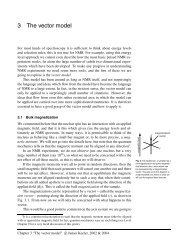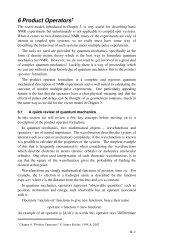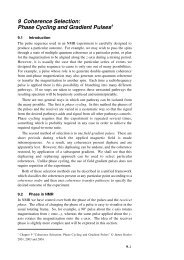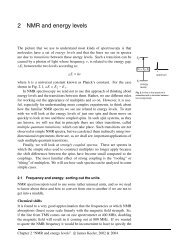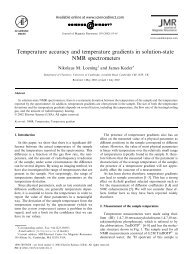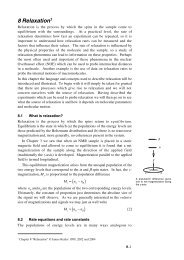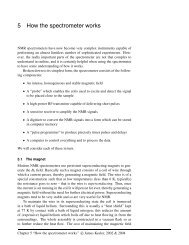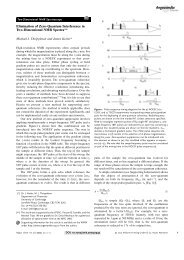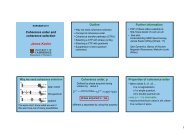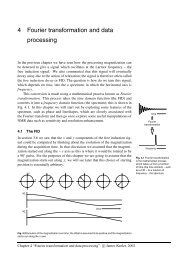Phase Cycling and Gradient Pulses - The James Keeler Group
Phase Cycling and Gradient Pulses - The James Keeler Group
Phase Cycling and Gradient Pulses - The James Keeler Group
You also want an ePaper? Increase the reach of your titles
YUMPU automatically turns print PDFs into web optimized ePapers that Google loves.
magnetic field is made spatially inhomogeneous for a short time. As a result,<br />
transverse magnetization <strong>and</strong> other coherences dephase across the sample <strong>and</strong><br />
are apparently lost. However, this loss can be reversed by the application of a<br />
subsequent gradient which undoes the dephasing process <strong>and</strong> thus restores the<br />
magnetization or coherence. <strong>The</strong> crucial property of the dephasing process is<br />
that it proceeds at a different rate for different coherences. For example,<br />
double-quantum coherence dephases twice as fast as single-quantum coherence.<br />
Thus, by applying gradient pulses of different strengths or durations it is<br />
possible to refocus coherences which have, for example, been changed from<br />
single- to double-quantum by a radiofrequency pulse.<br />
<strong>Gradient</strong> pulses are introduced into the pulse sequence in such a way that<br />
only the wanted signals are observed in each experiment. Thus, in contrast to<br />
phase cycling, there is no reliance on subtraction of unwanted signals, <strong>and</strong> it<br />
can thus be expected that the level of t 1<br />
-noise will be much reduced. Again in<br />
contrast to phase cycling, no repetitions of the experiment are needed, enabling<br />
the overall duration of the experiment to be set strictly in accord with the<br />
required resolution <strong>and</strong> signal-to-noise ratio.<br />
<strong>The</strong> properties of gradient pulses <strong>and</strong> the way in which they can be used to<br />
select coherence transfer pathways have been known since the earliest days of<br />
multiple-pulse NMR. However, in the past their wide application has been<br />
limited by technical problems which made it difficult to use such pulses in<br />
high-resolution NMR. <strong>The</strong> problem is that switching on the gradient pulse<br />
induces currents in any nearby conductors, such as the probe housing <strong>and</strong><br />
magnet bore tube. <strong>The</strong>se induced currents, called eddy currents, themselves<br />
generate magnetic fields which perturb the NMR spectrum. Typically, the eddy<br />
currents are large enough to disrupt severely the spectrum <strong>and</strong> can last many<br />
hundreds of milliseconds. It is thus impossible to observe a high-resolution<br />
spectrum immediately after the application of a gradient pulse. Similar<br />
problems have beset NMR imaging experiments <strong>and</strong> have led to the<br />
development of shielded gradient coils which do not produce significant<br />
magnetic fields outside the sample volume <strong>and</strong> thus minimise the generation of<br />
eddy currents. <strong>The</strong> use of this technology in high-resolution NMR probes has<br />
made it possible to observe spectra within tens of microseconds of applying a<br />
gradient pulse. With such apparatus, the use of field gradient pulses in high<br />
resolution NMR is quite straightforward, a fact first realised <strong>and</strong> demonstrated<br />
by Hurd whose work has pioneered this whole area.<br />
9.6.2 Dephasing caused by gradients<br />
A field gradient pulse is a period during which the B 0<br />
field is made spatially<br />
inhomogeneous; for example an extra coil can be introduced into the sample<br />
probe <strong>and</strong> a current passed through the coil in order to produce a field which<br />
varies linearly in the z-direction. We can imagine the sample being divided into<br />
thin discs which, as a consequence of the gradient, all experience different<br />
magnetic fields <strong>and</strong> thus have different Larmor frequencies. At the beginning<br />
9–33



